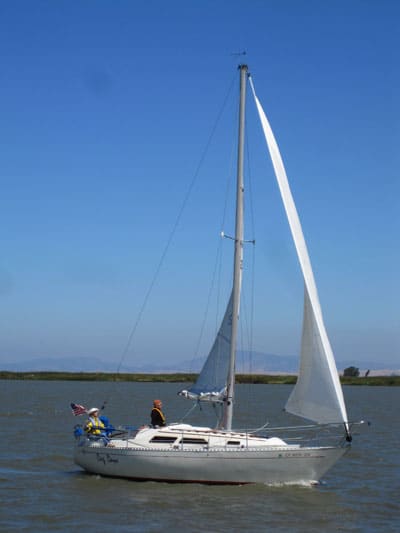
Islander Bahama 28
Islander Yachts launched the first Robert H. Perry-designed Islander 28 in July 1975, and over the next 10 years, the company, based in Costa Mesa, California, produced some 430 of the standard model plus about 25 of a variant called the Bahama 28.
I purchased Dog Days, a 1981 Islander Bahama 28, in August 2000 and sailed her for 10 years in the San Francisco Bay region. I was attracted to the boat by its raked bow, pretty sheer, reverse transom, and the way the lines of the cabin and its features blend well with the hull.
On top of being a real eye-catcher, the boat, with its 5-foot-6-inch draft and 3,300 pounds of ballast, sails beautifully, tracks well, and responds quickly to the helm. The standard model sails just as well with a 5-foot draft, and owners of the 4-foot shoal-draft keel option also praise its excellent handling.
The hull shape was influenced by the then-popular International Offshore Rule, but the 10-foot beam was unusually broad even then for a boat of this size. The configuration makes for a boat that’s fast and stable in a breeze and also sails well in light air.
The I-28 is masthead rigged. Its deck-stepped, single-spreader mast is stayed with cap shrouds, forward lower shrouds, a headstay, and a split backstay, and it’s supported by a steel compression post that stands on a wooden 4- by 4-inch beam resting on the keel. The shroud chainplates are located inboard on the wide side decks and secured to bulkheads.
The midboom mainsheet leads to a traveler mounted on the cabin top. Dog Days is equipped with two Lewmar 30 self-tailing primaries, two Lewmar 30 spinnaker winches, and three additional Lewmar 8 winches installed on the cabin top by her first owner.
The I-28 was the first Islander model built with a modular interior. The teak components were fabricated in the mill, assembled outside the boat, and installed in the hull before the deck was fitted. Hank McCormick, the head of marketing at Islander Yachts, strongly influenced the design of the interior with its stained-oak countertops, wicker-fronted teak cabinet doors, and a bulkhead-mounted folding saloon table.
On the Bahama model, the galley is U-shaped, with the icebox aft, a stove top in the center, and the sink facing the saloon. In the standard model, the galley is L-shaped with the sink aft.
On all models, the head is on the starboard side and has a stainless-steel basin and considerable storage space but no shower. Opposite the head are a bureau and a hanging locker. Storage spaces are located beneath the V-berth and the port settee (the water tank is under the starboard settee) and behind the settees. A 7-foot quarter berth is to starboard. The engine is below the companionway steps, and the fuel tank is under the cockpit sole.
I found only two serious weaknesses on Dog Days. One was water intrusion around the chainplates and stanchions, which could eventually damage the plywood-cored deck.
The other problem common to Islanders is a “smile” that can develop should the leading edge of the keel separate from the hull. I discovered that the keel bolts had rusted in the shallow bilge and couldn’t be tightened. I had to grind off and replace the nuts.
This comfortable and quick coastal cruiser sells for as little as $8,000 to $16,000 and is a stand-out among rival 28-footers of a similar age.
Islander Bahama 28
LOA 27′ 11″ (8.51 m.)
LWL 23′ 1″ (7.04 m.)
Beam 9′ 11″ (3.02 m.)
Draft (standard) 5′ 0″ (1.52 m.)
Sail Area (100%) 361 sq. ft. (33.5 sq. m.)
Ballast 3,000lb. (1,361 kg.)
Displacement 7,000 lb. (3,175 kg.)
Ballast/D .43
D/L 254
SA/D 15.8
Water 20 gal. (75.8 l.)
Fuel 20 gal. (75.8 l.)
Engine Various
Designer Robert H. Perry
James C. Williams now owns a Cabo Rico 36, which he’s sailed for three years on the Eastern Seaboard.








